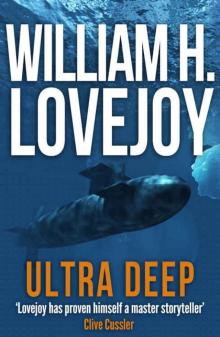- Home
- William H. Lovejoy
Ultra Deep Page 2
Ultra Deep Read online
Page 2
“What are we making, Jim?”
“Still at the top end, twenty-six knots.”
Brande went back to staring at the invisible horizon. The stars were clear and cold. A phosphorescent glow below the surface off to starboard suggested a school of fish.
“For someone who’s spent so much time at sea, Chief, you’re not very patient,” Word said.
“I hate waiting rooms.”
The theme song from the The Bridge Over the River Kwai, whistled through a chipped front tooth, announced the imminent arrival of Maynard Dokey, expectedly called ʻOkey.ʼ He emerged from the curtained hatchway to the radar/sonar room, gripping his omnipresent coffee mug. The mug sported a picture of two whales amorously eyeing each other, communicating in question marks. Okey Dokey was as well known for his personally designed mugs and T-shirts as he was for his expertise with a screwdriver, a computer, and an electronic schematic.
Today’s T-shirt was conservative. No artwork, just the motto, WANNA SCREW? Dokey was fond of questions, and many of the women working for Brande’s Marine Visions Unlimited had taken to wearing shirts that screamed, NO! in various fonts and styles.
“Ringling Brothers’ train got there ahead of us,” Dokey said.
Brande turned to look at him. “A real circus, huh?”
“Radar shows twelve boats are in the area,” Dokey told him.
“I’ve got ten bucks says eleven of them are only getting in the way.”
“That’s not a bet,” Word said. “That’s your typical moneymaker.”
“How far?” Brande asked.
“Call it nine miles to first contact, Dane.”
“Do you think George Dawson has really got something?” Word asked.
“I hope so,” Brande said. “We need the contract.”
George Dawson, who captained the salvage vessel Grade, had called Brande at his San Diego office early that morning. Brande had asked four questions, proposed a percentage, then called Dokey, then called United Airlines for reservations. Fortunately, the Gemini was in Houston for service and supply after a three-month surveying stint for the U.S. Naval Oceanographic Office. He had called Jim Word to warn him of their arrival in Houston as he and Dokey left the office for San Diego International Airport.
When the running and anchor lights of a large flotilla of vessels appeared ahead of them, Brande opened the side door and stepped out onto the small starboard bridge wing. Directly behind him, a ladder descended to the main deck. He leaned into the railing and felt the Gemini shift slightly as Mason altered course slightly to port. Crew members, male and female, appeared on the narrow side deck from cabin and work areas and moved to the railings to watch their arrival.
The open gridwork on which he stood thrummed with the vibration from the big diesel engines. The vibration died away as they neared the motionless boats and Word ordered the throttles retarded.
It looked like a small community, a village on the plains. Each of the boats in the cluster had its deck lights illuminated, along with a few searchlights, and the whole area had a moonlit quality to it. As the Gemini approached at ten knots, Brande saw people moving about on board most of them. There was a wide variety of craft represented: several salvage vessels, an oceangoing tug, and power cruisers of various length. Most of them were aged. He couldn’t miss Curtis Aaron’s Justica. It was a thirty-year-old, sixty-foot Hatteras, barely refurbished to seaworthiness. The Justica was painted white, with four-foot-high, squared-off black letters painted along each side of its hull: OCEANS FREE. The Justica was the Atlantic and Caribbean representative of Aaron’s zealous organization. On the Pacific side, it was the Queen of Liberty.
When they were a quarter-mile away, a vessel near the center of the cluster blinked its anchor light. Mason eased off on the throttles some more and threaded his way through the gaggle of boats toward the broad-beamed salvage boat, Grade. It was 160 feet long and, though elderly, in excellent condition. The Gemini dwarfed it as she came alongside. Crew members fore and aft suspended fenders over the side to keep the hulls from scraping each other, then grabbed the lines thrown to them. The research vessel was snugged up against the salvage boat.
Captain Word deployed the cycloidal propellers. Under both bows and both sterns of the Gemini’s twin hulls, flush panels folded open and the cycloidal propellers — appearing like oversized egg beaters — were extended downward. The propulsion system, modeled after that utilized on the U.S. oceanographic research ship Knorr — which was used in discovering the grave of the Titanic — made Brandeʼs vessel one of the most stable on the seas. Governed by computer control and driven by linkage to the two diesel engines, the four cycloidal propellers allowed the helmsman to shift the ship forward, backward, sideways, or in rotation in very small increments. Tied into the NavStar Global Positioning Satellite system, the computer could maintain the Gemini’s almost-exact position in both calm and heavy seas.
Brande descended from the bridge wing to the deck, followed by Maynard Dokey.
Brandie Anderson, dressed in cut-off jeans and a NO! T-shirt, and crewing for a six-month period as an intern from Rice University, operated the winch controls which lowered the starboard gangplank to a few feet above the lower deck of the salvage ship.
Brande gave her a thumbs-up as he unhooked the safety line in the railing.
Dokey started to say something, but Brandie pointed at her shirt.
“You’re going to have to start developing a new reputation, Okey,” Brande told him.
“Hell, I’ve already got the best one there is, Chief.”
The two men made the descent and paused at the bottom landing for both ships to stabilize on the same wave for a moment before jumping the last couple of feet to the deck of the Grade.
George Dawson was waiting for them. Weatherbeaten and nearly bald under a rumpled and disreputable billed cap, Dawson had a grin that was face-wide and revealed strong and yellowed teeth. He gripped half a giant and dead cigar in one corner of his mouth. He was barrel-chested and big, standing six-four. Brande rarely met men his own height, but he thought that Dawson outweighed him by a hundred pounds. Brande weighed 215.
Dawson stuck out a big, gnarled fist, and Brande, then Dokey, shook it. His hand was as callused and as hard as the rest of him.
“Damned glad to see you, Dane.”
With a palm-up gesture, Brande indicated the boats around them. “You invite everyone to the party, George?”
“Hell, no. Couple of these guys, Figlon on the Osprey especially, are always dogging me, hoping to pick up a couple bones I miss. The rest of them, I reckon, listened in on my ship-to-shore call to you this morning. Fucking maggots is what they are.”
Dokey looked around the deck. “I thought you might have invited Curt Aaron over for tea, George.”
“No, but the sucker sent over a list of demands.”
“Such as?” Brande asked.
“That I leave the ocean bottom as it is. It’s against God’s will to disturb nature.”
“He’s going to go off the deep end real soon,” Dokey said.
“Sooner the better, as far as I’m concerned,” Dawson said. “Maybe somebody will shoot him and put him out of our misery. Come on, let’s go forward to the wardroom and get the legal crap out of the way.”
They followed Dawson toward the bow along the side deck. Like themselves, Dawson walked with the wide stance of a sailor who knew his world might tilt on him at any moment.
Entering through the pilot house, Dawson led them aft through a hatchway into a communal mess. The walls were painted beige, and several dozen artifacts recovered from the sea bottom were displayed in deep, glass-fronted frames. A bronze urn, flattened by some unknown catastrophe, a saber with a silver-filigreed hilt, a pair of ceramic mugs labeled Lusitania, a brass lantern, a ship’s wheel.
Dawson filled chipped ceramic mugs with strong coffee, and they settled onto benches at a Formica-topped table.
“You’re pretty damned sure of what you�
��ve got?” Brande asked.
“You bet I’m sure.” Dawson leaned back and picked a manila envelope off a cabinet built into the bulkhead. “Sneaky took these.”
From the envelope, Dawson extracted a stack of 35-millimeter photographs. They were black-and-white. He peeled them from the stack, one by one, and passed them around.
“Sneaky” was “Sneaky Pete.” One of the first tethered exploration robot models developed by Marine Visions Unlimited, the robot had once had a more exotic name, but it had vanished in favor of the current sobriquet when a graduate student from UC-San Diego discovered that the robot’s video system captured wonderful images of a trio of nude female divers.
MVU did not yet sell its working robots, but in some cases, it did lease them. Currently, Brande had seven of the sophisticated and compact Sneaky Petes leased to research and salvage firms.
“I’ve got videotape we recorded from the video camera, too, if you want to see that,” Dawson said.
“This’ll do,” Brande told him as he leafed through the photos.
In black-and-white, the images were stark, the objects highlighted by the beams of the halogen lamps mounted on Sneaky Pete’s forehead. The areas around the objects were murky. The photographs had been taken at depths where the sun did not penetrate.
Dokey held up a photograph and turned it to Dawson. “Cannon?”
“Yeah. That was our lead contact” Dawson unparked his unlit cigar from his teeth just long enough to take a swig of his coffee.
Brande looked over at the photo. It took a trained eye and a good imagination to see a cannon in it. The bottom silt had drifted over most of it, and only the butt end, with a partial knob, was visible.
“We were trailing a side-scan sonic array,” Dawson said, “and got a ping off that chunk of metal. Came back around and got the same ping, but there was nothing else in the area. Hell, I almost decided to skip it, then thought we could take the time to send Sneaky down.”
“Depth?” Brande asked.
“Eleven hundred feet. But I wasn’t going to suit up a diver for one damned cannon. Well, I might have, just to look for traceable numbers. So we roamed Sneaky to the south and found the trench.”
“That’s where these are?” Brande asked, holding up a sheaf of snapshots.
“Right. It’s a steep canyon, and I’m estimating the bottom at maybe seven thousand feet. The terrain on the canyon side is rough, and the ingots are spread all over the side of it, about five thousand feet down.”
Brande checked the photos again. Almost all of them focused on one or two gold ingots. They were roughly forged, and all but buried in the silt. A corner here, and an edge there, protruded from the soil of the canyon side.
“How many?” Dokey asked.
“We got shots of fourteen. Looks like they’re cast at about sixty pounds. Those Spaniards didn’t want ’em light enough for anyone to carry for very long.”
“You get any pictures of an imprint?” Brande asked.
“No. Bet you they’re sixteenth century, though. South American gold. I’ve been through my whole damned library, but I can’t find one mention of a ship lost in this particular area of the Caribbean. Of course, the Spanish lost a bunch without knowing where they lost them.”
“Say we haven’t got an historical find,” Brande said, “on today’s markets, the straight gold that’s visible…”
“Will bring in better than four-point-five million,” Dokey finished.
“There’s more than fourteen ingots,” Dawson said. “Bet on it.”
“How about artifacts?” Brande asked.
“I think we’ll find something. That ship went down in heavy weather, broke up, and most of it tumbled down the canyon. Probably hooked up on a ledge or something. Broke apart in the currents over the years, and spilled everything down the side of the trench. The debris field may be scattered a mile or more wide.”
“You see anything else?”
“Maybe the lip of a goblet. Silver, I’d think. Maybe a couple of ribs from the hull, but they’re pretty well rotted out.”
Brande looked over a picture that was taken from a greater distance. When he knew that he was looking at the side of the trench, rather than down on the bottom, it looked more treacherous.
“I wouldn’t want to risk a man’s life digging into that,” he said.
“Nor would I,” Dawson agreed. “I don’t want to use my manned submersible. That’s why you’re here. That’s why you brought your toys along.”
In addition to the fact that he needed the money pretty badly, Brande thought, but did not mention that. If all he took out of it was a million dollars, he could at least meet the bills for a month. Almost. He had taken greater risks.
“MVU gets twenty-five percent,” Brande said.
“That’s what we talked about.”
“Anything of historical significance…”
“We’re in international waters,” Dawson countered.
“… will be offered to the appropriate museums at our cost of recovery. That comes off the top, before we divvy up the balance. And we have to get that cannon barrel up, so we can look for clues.”
“Goddamn, Dane. There you go again, getting all mushy.”
“Can’t help it, George. I’m a romantic.”
“Get your goddamned papers out.”
*
0855 HOURS LOCAL, PLESETSK COSMODROME
*
TIME TO LAUNCH: 00:04:54.
The main screen view of the A2e rocket on its pad had not changed a great deal in two hours. The first white spray of dawn was infiltrating across the tundra, but there was little differentiation between the lightly snow-frosted plain and the concrete ribbons of roads around the pad, also coated with yesterday’s snow.
There were no figures scurrying around the base of the gantry now. All of the technicians and scientists had retreated to their bunkers.
The rocket was clearly visible without the aid of floodlights. It stood, massive and smooth and black, with a single red star on the upper stage, like a monolith at Stonehenge. Vapors escaped from various hoses connected between the rocket and the gantry. The additional booster cylinders attached to each side were at least half as tall as the primary rocket.
As he watched, Oberstev saw the gimbal-mounted nozzles of the main rocket motor swivel briefly, part of 2m automatic pretest sequence.
TIME TO LAUNCH: 00:04:48.
The console beside Dmitri Oberstev’s chair reported: “The MiG-25s are orbiting on station, General.”
Two MiG-25 aircraft, called Foxbat by NATO, were stationed at 10,000 meters of altitude, ready to give chase as soon as the A2e was launched. Capable of three times the speed of sound, the reconnaissance aircraft would be able to follow the rocket for some distance, up to an altitude of 25,000 meters, photographing its performance. Once the ground-tracking cameras lost sight of the A2e, the cameras aboard the MiGs would take over, transferring the image of the accelerating rocket to earth-based monitors.
And on to the millions of Commonwealth citizens watching their televisions.
On the pad, the gantry arms cradling the rocket shifted outward then retracted. The gantry moved back several meters. Only the umbilical cords remained draped from the gantry to the vehicle. On launch, they would drop away and the top portion of the gantry would tilt back, giving the rocket added clearance.
TIME TO LAUNCH: 00:04:22.
Oberstev removed his glasses and polished the lenses with a linen handkerchief. Resettling them on his thin nose, he looked around his private observation room. His aide, Colonel Alexi Cherbykov, stood at the samovar, drawing tea into glasses set in silver holders. He had chosen Cherbykov, immaculately groomed in a fresh uniform, for his assistant because he was such an efficient officer. Diplomatic, also. He handled the visiting dignitaries with grace and charm, a function for which Oberstev had little patience. The general was far more interested in producing results than he was in the processes — especially political pr
ocesses — that swirled around his project.
Cherbykov walked across the room, balancing a silver tray on upraised fingers, and presented it to the visitor. Vladimir Yevgeni, a member of the national parliament’s subcommittee on aerospace, absentmindedly selected a glass from the tray. A senior lieutenant whose name Oberstev could not remember, offered a plate of Dutch cheeses and pastries, but was waved off by the politician.
It was Yevgeni’s first visit to the Plesetsk Cosmodrome during a launch, which Oberstev saw as a major failing in a member of the aerospace committee, much less the chairman of the committee.
Yevgeni had pulled one of the leather chairs up close to the wall of glass overlooking the control center and settled his heavy body into it. Vladimir Yevgeni was close to eighty years of age, Oberstev thought. He was an ultraconservative, representing a large conservative constituency. He would have been a coup plotter, then a defrocked detainee, if he had not been in England for a heart bypass operation at the time of the coup. His pate was shiny and smooth, and his heavy jowls sagged like those of a sad hound. His expensive charcoal suit, laced with thin vertical silver stripes, did not hide the flab layered around his waist.
Yevgeni was one of the cadre who supported having a celebration of the Revolution, rather than the New Order. “Our history does not disappear with our evolution,” he had argued in both the national parliament and the Russian parliament. Vladimir Yevgeni would never acknowledge a mistake made by Russian or Soviet people, but his displeasure at the termination of the traditional October festivities was widely known.
Oberstev asked, “Is there anything we can get for you, Comrade Chairman?”
Though the ʻcomradeʼ form of address was growing sparse in the Commonwealth as a result of the Party’s deteriorating membership, it was certainly a requirement when addressing Yevgeni. He was an idealist of the highest grade and surely, Oberstev thought, one of the silent group alarmed at the foreign and domestic policy strategies that had taken radical turns.
“Not a thing, General Oberstev. I am quite content.”

 Ultra Deep
Ultra Deep Phantom Strike
Phantom Strike Delta Blue
Delta Blue Alpha Kat
Alpha Kat Seaghost
Seaghost